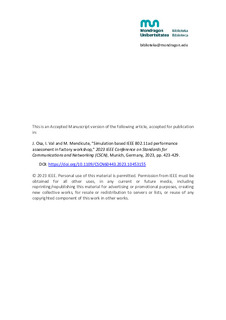
Izenburua
Simulation based IEEE 802.11ad performance assessment in factory workshopEgilea (beste erakunde batekoa)
Argitalpen data
2023Beste erakundeak
MaxLinear Inc.Bertsioa
PostprintaDokumentu-mota
Kongresu-ekarpenaKongresu-ekarpenaHizkuntza
IngelesaEskubideak
© 2023 IEEESarbidea
Sarbide irekiaArgitaratzailearen bertsioa
https://doi.org/10.1109/CSCN60443.2023.10453155Non argitaratua
IEEE Conference on Standards for Communications and Networking (CSCN). Munich (Germany), 6-8 November, 2023 Argitaratzailea
IEEEGako-hitzak
measurement
Communication systems
reliability
Millimeter wave communication ... [+]
Communication systems
reliability
Millimeter wave communication ... [+]
measurement
Communication systems
reliability
Millimeter wave communication
Antenna radiation patterns [-]
Communication systems
reliability
Millimeter wave communication
Antenna radiation patterns [-]
Laburpena
The IEEE 802.11ad standard exploits the millimeter wave (mmWave) spectrum, concretely the license-free frequency band in the 57-71 GHz range. Nowadays, this frequency band is mostly unused for use cas ... [+]
The IEEE 802.11ad standard exploits the millimeter wave (mmWave) spectrum, concretely the license-free frequency band in the 57-71 GHz range. Nowadays, this frequency band is mostly unused for use cases related to communication systems, and applications that require a throughput of several Gbit/s are proposed to fully exploit all the resources that are offered in this spectrum. Another option could be to exploit the advantages offered in the mmWave spectrum to increase the reliability and timing requirements of the networks, which are key aspects in industrial communications. However, this approach has not been tested yet due to the novelty of mmWave bands for communication systems, which is the main motivation behind this work. This paper performs an assessment of the expected performance of an IEEE 802.11ad managed industrial backhaul network using a simulation based approach. The simulation is split in two: an individual link is tested first under several conditions with a realistic channel model and the whole network is evaluated after, using the previously generated metrics to represent the links. The obtained results show that, even if 802.11ad does not provide a sufficient performance to cope with the most stringent use case, the standard has potential to operate in this kind of environment. [-]




















